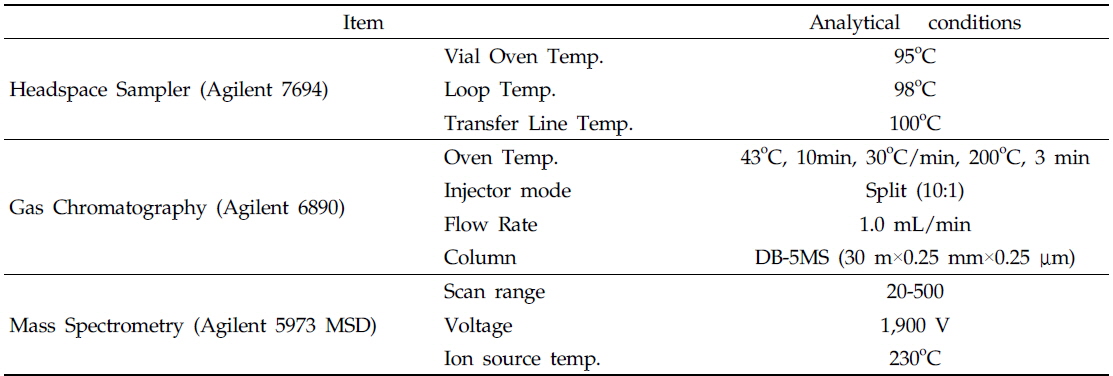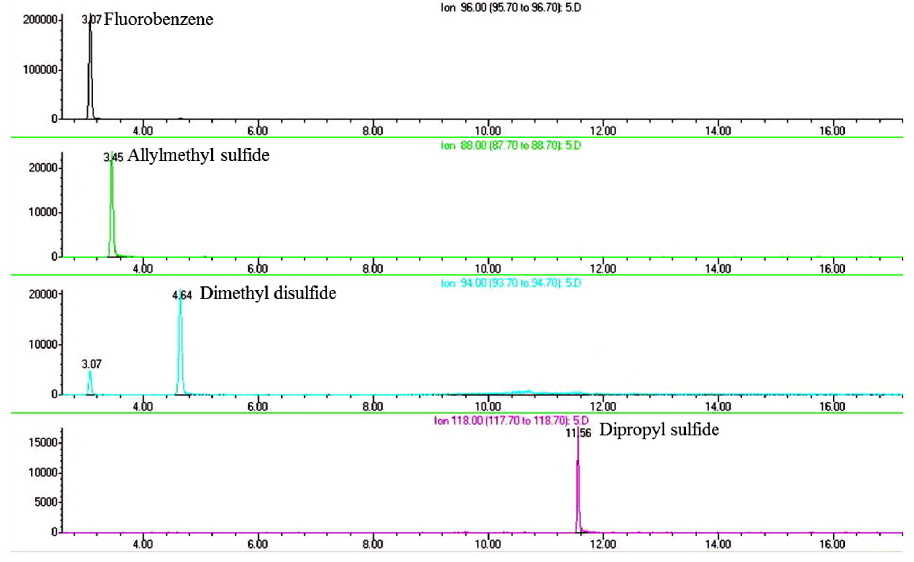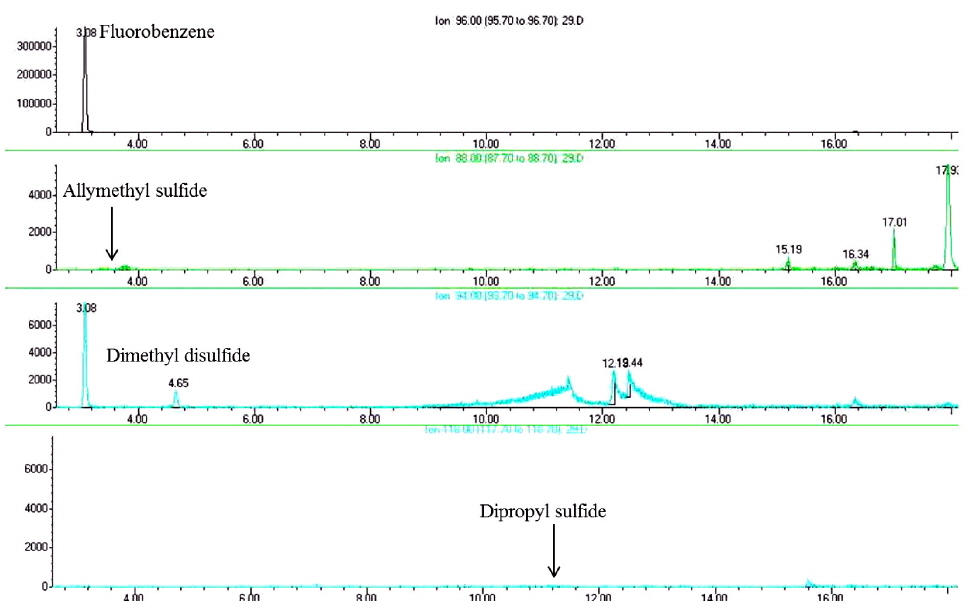



국민의 건강과 환경을 중요시하는 웰빙욕구의 확산과 우리나라 친환경농업 실천농가 및 재배면적 확대로 인한 친환경 농산물 생산과 소비가 빠르게 증가하고 있다(Kim
지중해 연안, 아시아, 아프리카 및 유럽에 광범위하게 분포하는 마늘 (
우리나라 친환경농업육성법은 마늘추출물을 유기농자재의 자재로서 허용하고 있어 마늘추출물을 함유한 유기농자재 9개 제품이 현재 국내에서 유통되고 있지만, 이들 모두 작물보호를 위한 유효성분명과 함량의 표기 없이 유통되고 있다. 최근 Lim 등(2014)은 마늘추출물 함유 유기농자재 중 마늘의 고유성분으로서 다량으로 함유되어 있는 휘발성의 작물보호활성 성분 DADS, DATS 및 DMDS를 지표성분으로 선정하고, hydrophilic lipophilic balance (HLB) 카트리지 정제방법을 사용한 gas chromatography (GC, flame ionization detector) 분석법을 보고한 바 있다. 또한 시료전처리 과정이 요구되지 않아 분석시간을 크게 단축할 수 있는 head-space sampler 장치는 다수의 휘발성 물질 분석에 사용되어 왔다(Oston and Kumarathasan, 1995; Escobal
본 연구에서 지표성분 후보로 선정된 alliin, allicin, AMS, AS, DPS, DMDS, DADS 및 DATS는 CromaDex(California, USA)로부터 구입하여 사용하였고, dimethyl sulfoxide (DMSO)와 내부표준물질 fluorobenzene은 Sigma-Aldrich Korea (Yongin, Korea)로부터 구입하여 사용하였다. 또한 9개의 마늘추출물 함유 유기농자재(150-1000 mL 액제)는 국내의 7개 제조사로부터 구입하여 사용하였다.
마늘의 고유성분으로 다량 함유되어 있으며 작물보호활성을 나타내는 물질 alliin, allicin, AMS, AS, DPS, DMDS, DADS 및 DATS 성분을 마늘추출물 함유 유기농자재의 지표성분 후보물질로 선발하였다. 선발된 지표성분 후보물질들의 기기분석 가능성을 검토하기 위하여 100 mg/L의 저장액으로부터 20 mL의 head-space vial에 10 mg/L 수준이 되도록 희석하고, 여기에 내부표준물질 10,000 mg/L fluorobenzene 10 μl를 가한 후 총 부피가 3 mL가 되도록 dimethyl sulfoxide (DMSO)를 첨가하여 head-space sampler가 장착된 GC-MS로 분석하였다. 후보 지표성분들 중 분석이 가능한 AMS, DMDS 및 DPS를 마늘추출물 함유 유기농자재의 지표성분으로 선정하였다.
지표성분 AMS, DMDS 및 DPS는 DB-5 MS (Agilent, USA) column을 사용하여 각각 88, 94 및 118 m/z를 정량이온, 61과 73, 64와 79, 76과 89 m/z를 정성이온으로 하여 head-space sampler가 장착된 GC-MS (Agilent, USA)의 selected ion monitoring (SIM) mode로 분석하였으며 기기분석 조건은 Table 1에 나타냈다.
[Table 1.] Analytical conditions for allylmethyl sulfide, dimethyl disulfide, and dipropyl sulfide

Analytical conditions for allylmethyl sulfide, dimethyl disulfide, and dipropyl sulfide
본 연구에서 확립된 분석법을 검증하기 위하여 검량곡선의 직선성은 20 mL의 head-space vial에 0, 0.1, 0.5, 1, 5 및 10 mg/L이 수준으로 첨가한 다음 여기에 내부표준물질 10,000 mg/L fluorobenzene 10 μl를 가하고, 총 부피가 3 mL가 되도록 DMSO를 첨가하여 Table 1의 조건에서 각각 5반복 실시하여 구하였다. 회수율 시험은 마늘추출물을 함유하지 않은 유기농자재를 증류수로 10배 희석한 다음 지표성분으로 선정된 AMS, DMDS 및 DPS를 각각 1과 2 mg/L 수준으로 첨가하여 3반복 실시하고, 이 결과로부터 회수율과 상대표준편차(relative standard deviation, RSD)를 구하였다. 정량한계(limit of quantification, LOQ)는 정량기기의 정량한계(Signal/Noise=10)를 측정하고, 정량한계 부근의 농도를 반복 측정하여 얻은 결과의 표준편차에 10배 한 값으로부터 계산하였다.
>
마늘추출물 함유 유기농자재 품질관리를 위한 지표성분 선정
마늘의 고유성분으로 다량 함유되어 있으며 작물보호 활성을 가지는 8개의 sulfide류 alliin, allicin, AMS, DMDS, AS, PS, DADS 및 DATS를 마늘추출물 함유 유기농자재의 품질관리를 위한 지표성분의 후보물질로 조사하였다. 표 1의 기기분석 조건에서 8개의 후보물질 중 AMS, DMDS 및 DPS는 간섭물질의 영향이 없는 머무름시간(retention time, RT)인 3.45, 4.64 및 11.56 분에 각각 검출되었으나 alliin, allicin, AS, DADS 및 DATS는 동일 분석조건에서 검출되지 않았다(Fig. 1). 따라서 AMS, DMDS 및 DPS를 마늘 추출물 함유 유기농자재의 품질관리를 위한 지표성분으로 선정하고, 이들에 대한 분석법을 검증하고자 하였다.
AMS, DMDS 및 DPS의 표준검량선은 0-10 mg/L의 각각의 표준용액의 peak 면적과 내부표준물질 fluorobenzene peak의 면적비로 작성되었다. 이들 물질의 표준검량선의 직선성은 상관계수(r2)가 0.9957 이상으로 양호하였고, signal-tonoise level의 10에 해당하는 값(MacDougall과 Crummett, 1980)으로 산출한 정량한계는 각각 0.08, 0.32 및 0.09 mg/L 이었다. AMS, DMDS 및 DPS의 회수율 시험은 이들의 혼합표준용액을 마늘추출물이 함유되지 않은 유기농자재에 1 mg/L 수준으로 첨가하고, 표준검량선 작성시의 동일조건에서 3반복하여 분석하였다. 1 및 2 mg/L 수준에서 실시한 AMS, DMDS 및 DPS의 회수율은 86.2-91.3%, RSD는 3.4-6.7%의 범위(Table 2)로 EU의 잔류분석법 가이드라인 회수율 70-120%, RSD 20% 이하의 기준에 잘 부합하였다(de Kok Food
[Table 2.] Validation parameters

Validation parameters
>
마늘추출물 함유 유기농자재 중 AMS, DMDS 및 DPS 함량
유통되고 있는 마늘추출물 함유 유기농자재 중 AMS, DMDS 및 DPS 함량을 개발된 분석방법을 적용하여 분석하였고, 대표적인 크로마토그램을 Fig. 2에 나타냈다. Table 3은 유통되고 있는 마늘추출물 함유 유기농자재 중 AMS, DMDS 및 DPS 함량을 나타낸 결과로, 이들의 함량은 각각 Content of allylmethyl sulfide, dimethyl disulfide, and dipropyl sulfide in commercial biopesicides containing A. sativum extract AMS (1.1 mM)는 시간 당

마늘추출물 함유 유기농자재의 품질관리를 위해 마늘의 고유성분으로 다량 함유되어 있으며 작물보호 활성을 지닌 8개의 지표성분 후보물질로부터 head-space sampler가 장착된 GC-MS로 분석 가능한 AMS, DMDS 및 DPS 3개 성분을 지표성분으로 선정하고, 이들 성분에 대한 동시분석법을 개발하였다.
이 동시분석법을 적용해 유통중인 마늘추출물 함유 유기농자재 중 선정된 지표성분들에 대한 분석결과는 작물보호를 위해 요구되는 농도 수준보다 적게 함유되어 있음을 나타냈다. 따라서 본 연구에서 계발된 분석법은 많은 시간을 요구하는 시료전처리 과정 없이 신속하게 AMS, DMDS 및 DPS에 대한 정량분석이 가능하므로, 마늘추출물 함유 유기농자재의 품질관리를 위한 분석방법으로서 활용이 가능할 것으로 판단된다.





